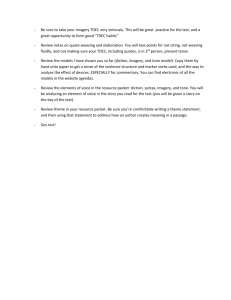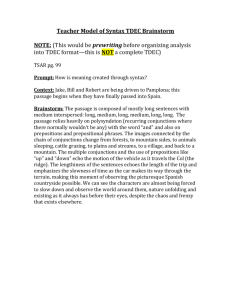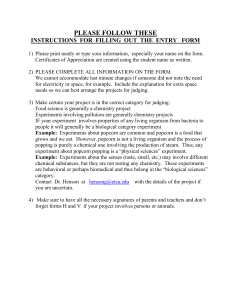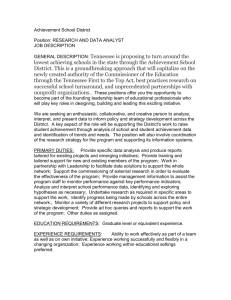Environmental Chemistry Laboratory
advertisement
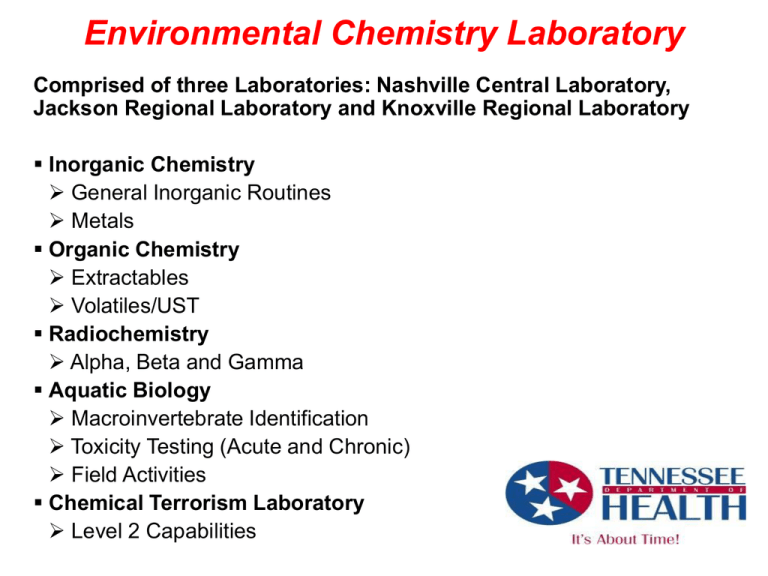
Environmental Chemistry Laboratory Comprised of three Laboratories: Nashville Central Laboratory, Jackson Regional Laboratory and Knoxville Regional Laboratory Inorganic Chemistry General Inorganic Routines Metals Organic Chemistry Extractables Volatiles/UST Radiochemistry Alpha, Beta and Gamma Aquatic Biology Macroinvertebrate Identification Toxicity Testing (Acute and Chronic) Field Activities Chemical Terrorism Laboratory Level 2 Capabilities Environmental Incidents in Tennessee Since 2007 Liberty Creek and Egyptian Lacquer Manufacturing Co. (ELMCO) January 2007 Facts: • In response to citizens complaints about strong odors along Liberty Creek, water and air sampling was conducted by Tennessee Department of Environment and Conservation (TDEC). The predominant chemicals found were acetone and toluene. • Egyptian Lacquer Manufacturing Company (ELMCO) reported to TDEC on February 13, 2007 that an above ground toluene tank was leaking. • A later investigation by ELMCO at the request of TDEC revealed that toluene and acetone pipelines were leaking into the subsurface. • Further investigation by TDEC revealed that acetone and toluene were entering Liberty Creek and Harpeth River through seeps along the banks. • The Organic Chemistry Section performed the initial volatile organics analyses that identified the acetone and toluene. • Quarterly monitoring samples from Liberty Creek are still being collected by TDEC and analyzed by Organic Chemistry. Middle Point Landfill and BSFR Policy May 2007 Facts: • In 1997, Tennessee developed a framework for disposing of lowlevel radioactive waste in a Class I landfill. The program has come to be referred to as the “Bulk Survey For Release (BSFR) Program.” • The sampling and measurement processes must indicate that any materials to be disposed of as part of the BSFR Program meet the strict criteria that have been established in Tennessee’s regulatory framework, i.e. must have a dose < one millirem per year. • The Middle Point Landfill was one of five facilities in Tennessee permitted to participate in the BSFR Program. • After reports in the news media concerning Middle Point Landfill and radioactive waste, local residents expressed concerns about potential contamination to their drinking water sources. • The Radiochemistry Section performed numerous gamma, gross alpha-beta and tritium analyses on landfill leachates and waste water treatment plant influents and effluents. TVA Kingston Coal Ash Spill December 2008 Facts: • On Monday December 22, 2008, around 1:00 a.m., the retention wall of one of the coal ash holding ponds failed. More than 5.4 million cubic yards of coal ash mixed with 327 million gallons of water spilled and covered more than 300 acres of surrounding water and land, entering a branch of the Emory River, two Emory River embayments, and eventually spilling into the main Emory River. • The massive ash slide disrupted power and ruptured a gas line, causing the evacuation of a nearby neighborhood. There were no immediate deaths or injuries caused by this extraordinary ash slide. • Tennessee Department of Environment and Conservation (TDEC) immediately implemented a water sampling plan for public water supply, well and surface water monitoring, and fish tissue monitoring. • TDEC also implemented sampling plans for air, soil and coal ash. • The Environmental Chemistry Sections, General Inorganics and Metals, performed TVA Kingston drinking water sample testing for 7 days a week for 1 month with a required 24-hour turnaround time on analytical results. • This was followed by drinking water sample collection for 5 days a week for 3 months with a required 24-hour turnaround time on analytical results. • The Environmental Chemistry Sections, Organics and Radiochemistry, performed testing on air, soil and coal ash samples. • Radiochemical and metals testing on air samples from TVA Kingston continues today. Nashville Flood May 2010 Facts: • The May 2010 Tennessee floods were 1000-year floods as a result of torrential rains on May 1 and 2, 2010. • Two-day rain totals in some areas were greater than 19 inches. • One of Metro Nashville’s two drinking water treatment plants was flooded, and taken out of operation. • Environmental Chemistry analyzed samples from this plant after it was brought back in operation to verify proper treatment conditions. • Environmental Microbiology analyzed a large number of samples from numerous drinking water treatment plants in Middle Tennessee for E. Coli. Japanese Nuclear Crisis March 2011 Facts: • On Friday, March 11, 2011, an earthquake of magnitude 9.0 and a 23-foot tsunami devastated Japan. • Cooling systems at the Fukushima Daiichi Nuclear Power Station failed which led to a nuclear crisis. • Fires and explosions at Reactors 1, 2 and 3 resulted in massive releases of radioactive material into the air, sea and land. • RadNet is EPA’s national network of monitoring stations that regularly collect air, precipitation, drinking water, and milk samples for analysis of radioactivity. • The RadNet network, which has stations in each State, has been used to track environmental releases of radioactivity from nuclear weapons tests and nuclear accidents. • The Radiochemistry Laboratory tested RadNet air, precipitation and drinking water samples for gammaemitting radionuclides, e.g. iodine-131, cesium-137 and tellurium-132. Iodine-131 Activity vs. Date Sampled 0.100 3/29/2011 0.090 0.080 pCi/m^3 I-131 Activity 0.070 12/28/2010 2/1/2011 2/22/2011 3/29/2011 4/11/2011 4/18/2011 4/26/2011 0.060 0.050 3/29/2011 3/29/2011 0.040 0.030 0.020 0.010 0.000 A11I A12I Iodine Cartridge Sample ID A13I What lessons can be learned from being involved in the response to these environmental incidents? • Preparation is KEY, but can you really respond in an effective and timely manner, i.e. capability vs. capacity issues. • A dedicated, knowledgeable and well-trained staff are CRITICAL. • PARTNERSHIPS, such as ERLN-WLA, are an important component of any response plan. • Lastly, environmental incidents or catastrophes far removed from your organization can have a strong impact on your operations. Preparedness continues to be a core focus for CDC. The best approach to preparedness is the best approach for public health – identify the problems you can do something about, develop and implement programs, rigorously evaluate their effectiveness, and look for ways to improve them. Thomas Frieden, MD, MPH CDC Director Questions? Contact Information: Bob Read, Ph.D. Director, Environmental Laboratories Tennessee Department of Health Division of Laboratory Services 630 Hart Lane Nashville, TN 37243 (615)262-6302 bob.read@tn.gov
